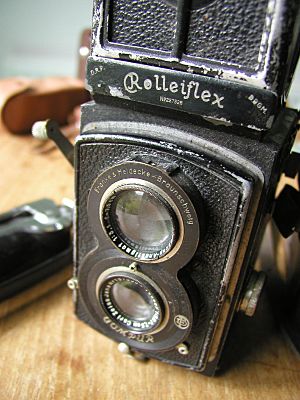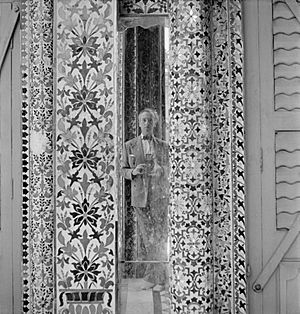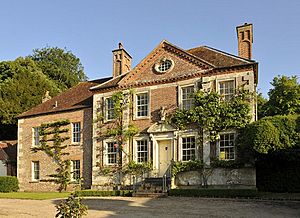Cecil Beaton facts for kids
Quick facts for kids
Cecil Beaton
|
|
|---|---|
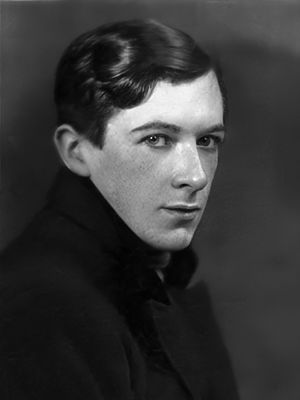
Portrait by James Lafayette, 1920s
|
|
| Born |
Cecil Walter Hardy Beaton
14 January 1904 |
| Died | 18 January 1980 (aged 76) Reddish House, Broad Chalke, Wiltshire, England
|
| Resting place | All Saints' church graveyard, Broad Chalke, Wiltshire |
| Education | Heath Mount School St Cyprian's School Harrow School St John's College, Cambridge |
| Occupation |
|
| Relatives | Baba Beaton (sister) Nancy Beaton (sister) |
Sir Cecil Walter Hardy Beaton (born January 14, 1904 – died January 18, 1980) was a very talented British artist. He was famous for many things, including fashion, portrait, and war photography. He was also a diarist, painter, and interior designer. On top of that, he won Oscars for his amazing stage and costume designs for films and theatre.
Contents
Early Life and Learning
Cecil Beaton was born in Hampstead, north London, on January 14, 1904. His father, Ernest Beaton, was a successful timber merchant, and his mother was Esther "Etty" Sisson. Ernest and Etty had four children: Cecil, his two sisters Nancy and Baba, and his brother Reginald.
Cecil went to Heath Mount School and then St Cyprian's School. Even at a young age, people noticed how artistic he was.
When Cecil was a child, his nanny had a Kodak 3A Camera. This was a popular camera, great for learning. His nanny taught him the basics of photography and how to develop film. He often asked his sisters and mother to pose for him. Once he got good, he would send his photos to London society magazines. Sometimes, he even used a fake name to "recommend" his own work!
Later, Beaton went to Harrow School and then St John's College at Cambridge University. He studied history, art, and architecture, even though he wasn't very interested in schoolwork. He kept taking photos, and through his university friends, he even got a portrait published in Vogue. He left Cambridge in 1925 without finishing his degree.
Career Beginnings
After a short time working in his family's timber business, Cecil Beaton tried working for a cement merchant. But his real passion was art. With help from a supporter named Osbert Sitwell, he held his first art show in London. It created quite a buzz!
Thinking he would do even better in America, he moved to New York. Slowly, he became well-known there. Eventually, he signed a big contract with Condé Nast Publications to take photos only for them, earning a lot of money each year.
From 1930 to 1945, Beaton rented Ashcombe House in Wiltshire, England. He often hosted many famous people there.
In 1947, he bought Reddish House, which had beautiful gardens. He completely changed the inside of the house, adding new rooms and features. Famous actress Greta Garbo even visited him there. He lived in Reddish House until he passed away in 1980 and is buried in the nearby churchyard.
Photography Work
Cecil Beaton designed book covers and costumes for special events. He learned a lot about photography at a studio before Vogue magazine hired him regularly in 1927. He opened his own studio, and one of his first clients and best friends was Stephen Tennant. Beaton's pictures of Tennant and his friends are considered some of the best images of the "Bright Young People" from the 1920s and 1930s.
Beaton's first camera was a Kodak 3A. Throughout his career, he used both large cameras and smaller Rolleiflex cameras. He wasn't known for being super technical with his camera. Instead, he focused on setting up a great scene or model and waiting for the perfect moment to take the picture.
He worked as a photographer for the British Vogue in 1931. He also worked for Vanity Fair and photographed many celebrities in Hollywood.
Beaton is especially known for his fashion photos and portraits of important people. After a difficult time, his career was saved by World War II. The Queen recommended him to the Ministry of Information. He became a leading war photographer, famous for his pictures of the damage caused by the German Blitz bombings in London.
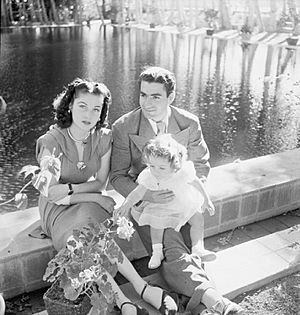
He often photographed the British Royal Family for official pictures. Queen Elizabeth The Queen Mother was his favorite royal person to photograph. He took the famous wedding pictures of the Duke and Duchess of Windsor. He also photographed Princess Margaret in a beautiful Dior dress for her 21st birthday in 1951. This became one of the most famous royal portraits of the 20th century.
During the Second World War, Beaton was asked to take pictures of life on the home front. He captured one of the most powerful images of British suffering during the war: a 3-year-old girl named Eileen Dunne recovering in the hospital, holding her teddy bear. When this picture was published, America had not yet joined the war. But images like Beaton's helped encourage Americans to push their government to help Britain.
Beaton also influenced other famous photographers like Angus McBean and David Bailey.
Stage and Film Design
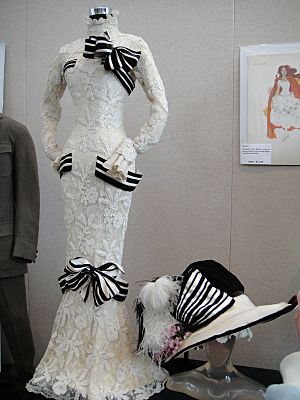
After the war, Beaton started working on Broadway plays. He designed the sets, costumes, and lighting for a play called Lady Windermere's Fan in 1946. He even acted in it!
His costumes for the musical My Fair Lady (1956) were highly praised. This led to him designing for two films based on musicals, Gigi (1958) and My Fair Lady (1964). He won an Academy Award for Best Costume Design for both of these films. He also designed costumes for the 1970 film On a Clear Day You Can See Forever.
He won four Tony Awards for his work on Broadway. He also designed the sets and costumes for a famous opera called Turandot, which was shown in New York and London.
Diaries
Cecil Beaton was also a well-known diarist. He wrote personal journals throughout his life. Six books of his diaries were published, covering the years from 1922 to 1974. These diaries give a glimpse into his life and the famous people he met.
Last Public Interview
Sir Cecil Beaton gave his last public interview in January 1980 for a BBC radio show called Desert Island Discs. The interview was recorded at his home, Reddish House, because he was quite frail. It was broadcast on February 1, 1980, shortly after he passed away.
Even though he was weak, Beaton remembered many events from his life, especially from the 1930s and 1940s, including the Blitz. He talked about his connections with Hollywood stars and the British Royal Family. He mentioned taking the official wedding photos of the Duke and Duchess of Windsor, and official portraits of Queen Elizabeth The Queen Mother and Queen Elizabeth II on her Coronation day. He also spoke about his lifelong love for performing arts, especially ballet and opera.
Later Life and Passing
Cecil Beaton was made a knight in 1972, which meant he was given the title "Sir."
Two years later, he had a stroke that left the right side of his body permanently paralyzed. Even though he learned to write and draw with his left hand and had his cameras changed to help him, Beaton felt limited by his stroke. Because of this, he worried about money for his old age. In 1976, he decided to sell his large collection of photographs to Sotheby's, a famous auction house. This sale helped ensure he would have an income.
By the end of the 1970s, Beaton's health got worse. He passed away on January 18, 1980, at Reddish House, just four days after his 76th birthday.
Awards and Recognition
Cecil Beaton received many awards for his incredible work:
- Tony Award for Best Costume Design for Quadrille (1955)
- CBE (1956)
- Tony Award for Best Costume Design for My Fair Lady (1957)
- Fellow of the Ancient Monuments Society (1957)
- Academy Award for Best Costume Design for Gigi (1958)
- Tony Award for Best Costume Design for Saratoga (1960)
- Chevalier de la Légion d'Honneur (1960) - A French honor
- Academy Award for Best Art Direction for My Fair Lady (1964)
- Academy Award for Best Costume Design for My Fair Lady (1964)
- Honorary Fellow of the Royal Photographic Society of Great Britain (1965)
- Tony Award for Best Costume Design for Coco (1970)
- Named to the International Best Dressed List Hall of Fame (1970)
- Knighthood (1972)
Exhibitions of His Work
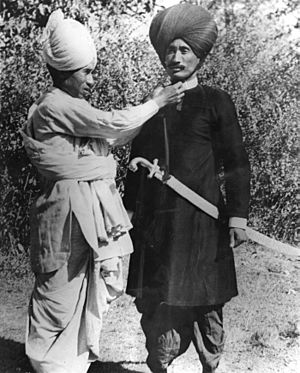
Many exhibitions have shown Cecil Beaton's work over the years:
- Major shows were held at the National Portrait Gallery in London in 1968 and 2004.
- The first international exhibition in thirty years was held in Bendigo, Australia, from December 2005 to March 2006.
- In October 2011, a painting by Beaton of rock star Mick Jagger was featured on the BBC's Antiques Roadshow. It was valued at £30,000.
- The Museum of the City of New York had an exhibition dedicated to Cecil Beaton from October 2011 to April 2012.
- An exhibition celebrating The Queen's Diamond Jubilee, showing her portraits by Cecil Beaton, opened in October 2011 at the Laing Art Gallery in Newcastle-upon-Tyne.
- "Cecil Beaton: Theatre of War" was a big show of his war photography at the Imperial War Museum in London from September 2012 to January 2013.
- "Cecil Beaton at Home: Ashcombe & Reddish" at The Salisbury Museum in Wiltshire (May-September 2014) focused on his two homes. It even included a full-size copy of murals from his Ashcombe house!
In Film and Television
Cecil Beaton has been shown in movies and TV shows:
- In the 1989 Australian film Darlings of the Gods, he was played by Shane Briant.
- In Netflix's 2016 series The Crown, Mark Tandy played Cecil Beaton.
Famous Photographs by Cecil Beaton
- Sir William Walton, 1926
- Stephen Tennant, 1927
- Lady Diana Cooper, 1928
- Charles James (designer), 1929
- Lillian Gish, 1929
- Oliver Messel, 1929
- Lord David Cecil, 1930
- Lady Georgia Sitwell, 1930
- Gary Cooper, 1931
- Molly Fink, 1926
- Pablo Picasso, 1933
- Helen Hope Montgomery Scott, 1933
- Dürrüşehvar Sultan, 1933
- Marlene Dietrich, 1935
- Salvador Dalí, 1936
- Natalie Paley, 1936
- Aldous Huxley, 1936
- Daisy Fellowes, 1937
- Helen of Greece and Denmark, Queen Mother of Romania, 1937
- Lady Ursula Manners, 1937
- Queen Sita Devi of Kapurthala, 1940
- Bomb Victim (Eileen Dunne), 1940
- Winston Churchill, 1940
- Graham Sutherland, 1940
- Charles de Gaulle, 1941
- Walter Sickert, 1942
- Maharani Gayatri Devi, Rajmata of Jaipur, 1943
- John Pope-Hennessy, 1945
- Isabel Jeans, 1945
- Greta Garbo, 1946
- Yul Brynner, 1946
- Princess Fawzia Fuad of Egypt, Queen of Iran
- Vivien Leigh, 1947
- Marlon Brando, 1947
- Truman Capote, 1948–1949
- Bobby Henrey, 1948
- Countess Cristiana Brandolini d'Adda, 1951
- Duchess of Windsor, 1951
- Vita Sackville-West, 1952
- C. Z. Guest, 1952
- Graham Greene, 1953
- Elizabeth II's Coronation, 1953
- Alexis von Rosenberg, Baron de Redé, 1953
- Elizabeth Taylor, 1954
- Grace Kelly, 1954
- Mona von Bismarck, 1955
- Bernard Berenson, 1955
- Joan Crawford, 1956
- Mrs. Charles (Jayne Wrightsman), 1956
- Maria Callas, 1956
- Dame Edith Sitwell, 1956
- Colin Wilson, 1956
- Marilyn Monroe, 1956
- Leslie Caron, 1957
- Dolores Guinness, 1958
- Princess Margaret, Countess of Snowdon, 1960
- Albert Finney, 1961
- Cristóbal Balenciaga, 1962
- Lee Radziwill, 1962
- Karen Blixen, 1962
- Rudolf Nureyev, 1963
- Audrey Hepburn, 1964
- Margot Fonteyn, 1965
- Jacqueline Kennedy, 1965
- Sheridan Hamilton-Temple-Blackwood, 5th Marquess of Dufferin and Ava, 1965
- Jamie Wyeth, 1966
- Georgia O'Keeffe, 1966
- Andy Warhol, 1967
- Twiggy, 1967
- Mick Jagger, 1968
- Katharine Hepburn, 1969
- Barbra Streisand, 1969
- Gloria Guinness, 1970
- Hubert de Givenchy, 1970
- Mae West, 1970
- David Hockney, 1970
- Jane Birkin, 1971
- Marie-Hélène de Rothschild, 1971
- Marisa Berenson as Luisa Casati, 1971
- Jacqueline de Ribes, 1971
- Pauline de Rothschild, 1972
- Tina Chow, 1973
- Gilbert & George, 1974
- Inès de La Fressange, 1978
- Paloma Picasso, 1978
- Caroline of Monaco, 1978
- Olimpia de Rothschild, 1978
- Dayle Haddon, 1979
See also
 In Spanish: Cecil Beaton para niños
In Spanish: Cecil Beaton para niños


